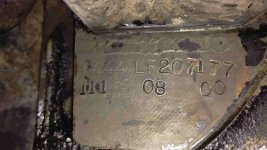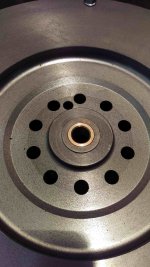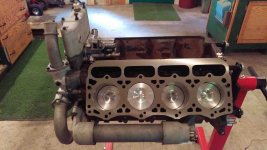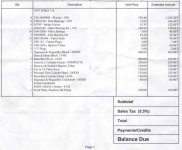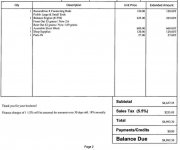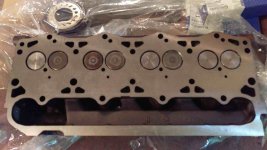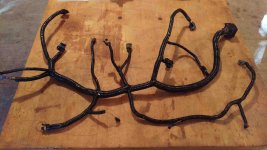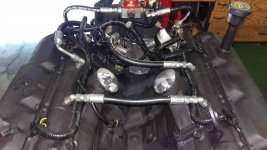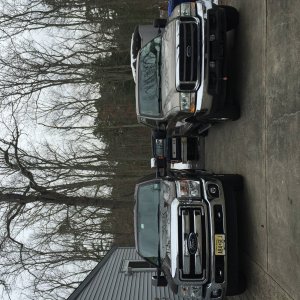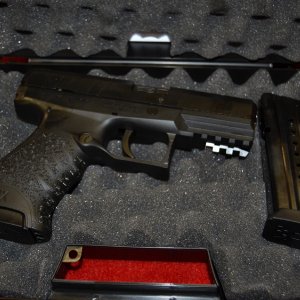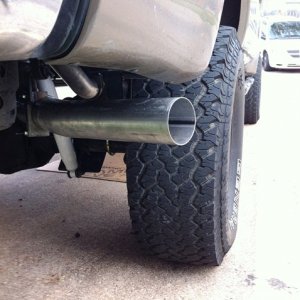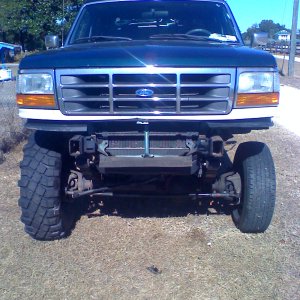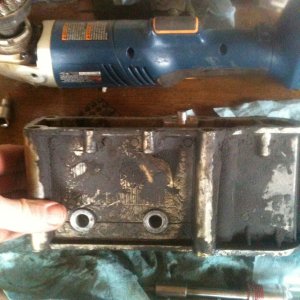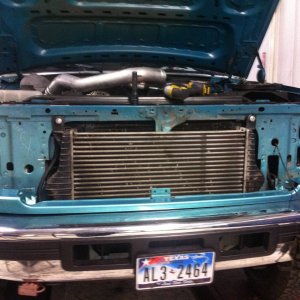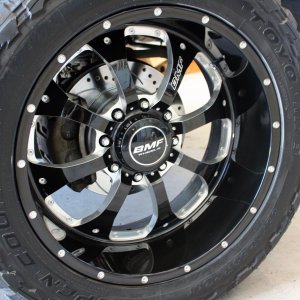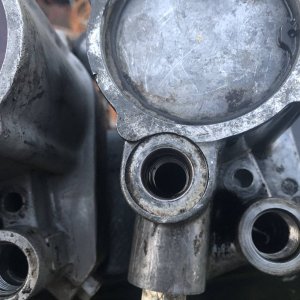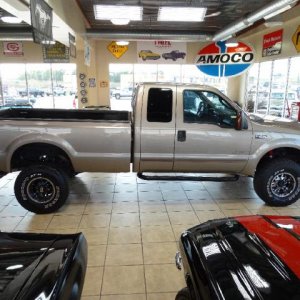It's been a while, it's finally together and in the truck sitting on it's biscuits. Nothing hooked yet. I'm thinking it should be running by the end of the week?
There was some challenges, but nothing some perseverance and money couldn't solve. I took a lot of pics documenting everything. If there is any interest? I will take the time to post some.
The cylinders needed 0.20" to clean them up. There now 30 over. This was a previous rebuilt Navistar long block. The previous owner's sun-in-law dusted this engine terribly. All the intake valve seats needed to be replaced. Decking the block required 0.003". The heads were fine. The bottom end got new (still) 0.010" under bearings. The block did not need line boring. The pistons and rods got balanced and then the entire rotating mass with balancer and clutch in place. Yes, I remembered to align the index marks when installing the clutch. I decided to use the stock balancer, since I tow a light camper and it has never experienced yellow line since I have owned it.
Machining was ~$4,800. Is anyone interested in seeing the actual machining invoice?
I thought I might do a first start video? Probably not?
As for paint, I gave that some thought. In the end, I decided to paint it their true color. Diesel greasy bastard black!
I have been talking to a few people and doing some research into what a proper break in involves? There is basically two camps, the believers and the knowers. This is what I currently align with. I obviously stole this from another site.
[FONT="]Part I
"Breaking-in" a new diesel engine. Many of the engine manufacturers claim that their engines do not require break-in. That is just pure baloney! Enough pestering and a few references to some of the Cummins shop manuals have painted a clearer picture. All engines require some kind of break-in period. This is even true with current technology. Although current technology provides the means of manufacturing engine parts with unimaginable precision, the manufacturer still falls far short of achieving the near perfect fit that a proper break-in will provide. “Break-in,” for the most part, is the allowance of the machined cylinder and ring surfaces to conform to each other’s shape during engine operation. This conforming or “mating” of ring and cylinder surfaces is the ultimate goal of a proper break-in. “Mating” these two specific parts will produce a very tight seal in each cylinder. A tight seal is very important because it prevents the escape of unburned fuel and pressurized gasses into the crankcase, while further preventing crankcase oil from entering the cylinder above the top compression ring. It is the intention of this article to help people understand more about the break-in process, and what happens or can happen during the first few thousand miles of engine operation.
During break-in, a small amount of compression blow-by, oil-fuel dilution, and oil consumption will be experienced. This is perfectly normal and quite common in new engines. Although acceptable at first it is imperative that these undesirable attributes be as close to zero as possible after break-in has been completed. Although the others are important, blow-by is the primary reason the ring and cylinder wall interface has to fit together so tightly. Diesel fuel needs to be introduced into an air environment that is under intense pressure in order for it to burn without an ignition source. When the fuel burns, the gasses produced multiply the compression pressure in the cylinder. Pressurized gasses that escape by means of the compression ring / cylinder wall interface are called blow-by gases. Pressure that escapes the cylinder in this manner results in a loss of energy. Whether it is pressure lost on compression or combustion, it is unable to be utilized to drive the piston through the power stroke. This loss ultimately results in a reduction of fuel mileage and power.
Today’s Diesels can take a "few" miles to fully break in. 10,000 miles is not an uncommon break-in period, especially for an engine like the Power Stroke Diesel. The reasons that break-in is such a lengthy process are generally attributed to engineering targets as well as the function of diesel combustion.
In terms of engineering targets, engine manufacturers produce diesel engines to sustain high torque loads over constant and extended load intervals. In other words, very durable parts are required to hold up to the rigors of diesel operating conditions. For example, The International Truck and Engine Company employ some very special parts in their 175 - 275 hp engines. The pistons used in these engines are manufactured from lightweight aluminum alloy, and are constructed with Ni-Resist ring inserts. The aforementioned piston combination is further complemented with keystone plasma faced rings. These rings help reduce oil consumption and can extend the life of the power cylinder further than ordinary chromium-plated rings. While chromium-plated rings continue to be produced for both diesel and gasoline applications, they are slowly becoming old technology. They still perform well but plasma faced rings have consistently shown superior performance.
When we consider the function of diesel combustion, we must first understand the engine dynamics that are associated with that process. In order for break-in to occur, a fair amount of heat, friction and resulting wear will have to take place before the compression rings will have “mated” with the cylinder walls. When the rings and cylinder wall are new, a modest amount of heat is created merely from the friction of the new rings passing over the freshly honed cylinder wall. While the heat from friction is significant, the real heat is created from combustion of fuel in the cylinder. When the fuel is burned, gasses are produced that expand and heat all of the cylinder parts. If enough fuel is introduced, the resulting combustion can create gasses that expand so much they will actually expand the cylinder wall and the compression rings. It is important to understand this because expanding these parts places additional pressure on them, which creates more friction and correspondingly more heat. This does not take into account the additional heat from combustion that will be added to the heat from friction. Heat is important to assist wear for break-in but too much can cause major problems. This is the reason we should not subject the engine to significant loading for the first 1000 miles of its operation. Loading heavily will introduce more fuel to the cylinder, and will add significant amounts of heat and pressure to the cylinder components. Couple that scenario with new rings on a freshly honed cylinder wall and we can only imagine the amount of friction and heat being produced and absorbed by the rings. Furthermore, the engine oil, lubricating the cylinder walls, will flash burn when it contacts the very hot rings. The burned oil will leave a hard, enamel like residue on the cylinder wall, commonly known as oil glazing. When the rings are permitted to operate under such high temperatures, oil glazing of the cylinder can happen very quickly. Once this glaze builds up, the only repair is a labor-intensive process that requires disassembling the engine and re-honing the effected cylinders. Oil glazing is a problem because it is typically not distributed evenly in the cylinder, and the spaces that exist between the ring and cylinder wall are either still there or new larger ones are created. Oil glazing is typically thicker towards the top of the cylinder and it builds up in the areas where heating is the greatest. The glaze has very smooth and friction free properties that do not allow it to be scraped away by the rings. This inhibits further metal-to-metal wear between the cylinder wall and rings, preventing further mating of ring and cylinder. Thus, those small gaps between ring and cylinder surface will never seal. These spaces will then allow pressurized gasses and unburned fuel to escape into the crankcase, while allowing oil from the crankcase to enter the cylinder above the top compression ring.
Well why not run the engine at idle or under no load? This is bad too. It can create a similar condition to glazing. The rings need to expand a little during this initial break-in period, just not so much that they overheat and flash the engine oil. The engine needs to be moderately loaded in order to break in correctly. Running the engine under very light or no load prevents the oil film placed on the cylinder wall from being scraped away by the expanding compression rings. The rings will instead “hydroplane” or ride over the deposited oil film, allowing it to be exposed to the cylinder combustion. The oil film will then partially burn on the cylinder leaving a residue that will build up and oxidize over time. Eventually this leaves a hard deposit on the cylinder wall that is very similar to the glaze left from flash burning. My caution to those just running the engine as a normal daily driver (without some loading) and especially those who love to idle their vehicles, expect some VERY extended break-in periods (up to 30,000 miles). Expect oil consumption forever due to oil glazing. The rings never really seat well if they cannot expand from the dynamics and heat that a load produces. Expect poor mileage due to the passing of compression and combustion gasses around the compression rings. Additionally, expect to see increased bearing wear and engine wear due to the fuel passing the rings diluting the engine oil.
Thus, we can see that heavy loading and light loading can cause some major problems. Moderate loading is the key to a proper break in for the first 1000 miles. It permits the loose fitting piston rings to expand into the cylinder walls allowing them to perform double duty: First, scraping oil off the cylinder wall, and second, to create friction that will promote wearing the two surfaces to each other’s proportions. Furthermore, moderate loading will allow the rings to get hot but not to the point where it will flash the lubricating oil supplied to the cylinder walls. [/FONT]
Part II
Once the rings and cylinder have "mated," they will have worn away a considerable amount of their roughness. They will wear slower than they did when they were new. This reduced wear rate indicates the end of break-in, and a decrease in oil consumption should be obvious to the owner / operator. Furthermore, blow-by and fuel dilution should also be reduced but may not be so obviously evident. Be aware that engines employing Plasma faced ring technology will take a longer time to break-in. These rings tend to wear far slower than chromium-plated rings. The plasma ring’s hardness allows it to wear the cylinder wall in a more aggressive manner while only polishing the ring surface. Eventually the cylinder wall wears to the shape of the ring and subsequent cylinder wear evolves to a polishing process. This extended process drastically improves the sealing potential of the cylinder, which will correspondingly reduce blow-by and the amount of physical wear on these components. Therefore, we can safely say that the plasma faced ring / Ni Resist insert combination greatly extends engine life. Unfortunately, the price of this better seal is a longer break-in period.
So the big question is: How long does it take for an engine to break-in? Outside of the rings being hard as rocks and just taking their own sweet time to mate to the cylinder bores, the greatest factor is how the engine is broken-in. Most engines will be broken-in after running for some time, but some ways of breaking-in an engine are far superior to others as they are more likely to produce low blow-by and near zero oil consumption.
Therefore, I will lay out some recommended DOs well as definite DON’Ts:
1. DON'T run the engine hard for the first 50 to 100 miles. It is recommended that the engine be operated around the torque peak (1500 to 1800 RPM) in high gear. This loads the engine very gently, and allows the internal parts to "get acquainted" without any extreme forces.
2. DON'T let the engine idle for more than five (5) minutes at any one time during the first 100 miles. (Even in traffic.) Remember those loose fitting rings, and possible fuel-oil dilution that were noted above? (Fuel Dilution is very common when diesels idle, even with well broken-in engines.) Well, if that fuel is allowed to contact the main and rod bearings during break in (not really good at any time), you might be looking at an engine that will always consume some oil and one that may not produce power or mileage as expected. In the first few miles of break-in, the bearings are mating to the crank, rods, etc. It is imperative during this time that the lubrication qualities of the oil remain robust. Fuel in the oil will reduce its ability to absorb shock and float the rotating parts in their bearings. Contact between bearings and journals will occur more frequently which will result in additional friction wear. This will ultimately reduce the tight tolerances between the bearings and journals. What was originally a tight fit will be sloppy and will never be able to mate properly.
3. DO drive the engine at varying RPMs and speeds until about 1000 miles. The idea is to alternately heat and cool the rings under varying RPMs. Manual transmission-equipped trucks are the best for this as they typically employ engine compression to slow the vehicle during normal operation, this constantly allows for varied RPMs. This can also be done with automatic transmissions, but it requires that you manually downshift the transmission into the lower gears while driving. Typically, most people with automatic transmissions operate their vehicles in Drive or Overdrive gear positions without making these manual shifts. When their vehicle is decelerating and the speed falls below 38 mph the transmission has little influence on engine RPM. This is because the torque converter unlocks and the auto transmission does not downshift to lower gears in the same fashion that manually shifting does. My suggestion to those with auto transmissions is to find an empty parking lot in the evening, and drive back and forth across it in the lower gears. (This can be done with standard transmission trucks as well.) Each time revving her up close to redline and letting engine compression slow it back down. This gets the rings a bit hot, but the compression braking allows the pistons to cool with high oil spray flow and no fuel load. Keep doing this for a number of runs, or until boredom sets in.
4. DO put a load on the engine at around 1000 miles, and get the thing hot! Diesels are designed to work, and in many cases, they operate best under a load. Baptize your engine with a nice "initiation load," to introduce it to hard work. Keep the revs up (but watch the EGTs), and make sure the coolant temps rise. Hooking up your trailer and finding some hills to pull works great for this. After the 1000 mile pull, just drive it normally, always making sure to let the engine get up to normal operating temps (no 1-mile trips to 7-Eleven). Towing is ok but remember to not overload and to monitor your gauges carefully erring on the side of caution. Under these conditions, I have seen most diesels completely break-in between 10-15,000 miles, and have always been able to tell that point from mileage gains. One may also notice that the "symphony" of the engine also changes slightly at this point.
We know that Engine Manufacturers have built today’s diesel engines using state of the art technology. They have fashioned parts to match in near perfect fashion. We can understand, through this article, that breaking-in this modern marvel of technology is more important than the manufacturers have lead us to believe. Furthermore, we can appreciate that following their claims can result in an engine that is wrought with inefficiency, sloppy fitting parts, and oil consumption problems. Following the guidelines and warnings set forth in this article will provide anyone who desires maximum efficiency and power out of his engine many miles of trouble free operation.

